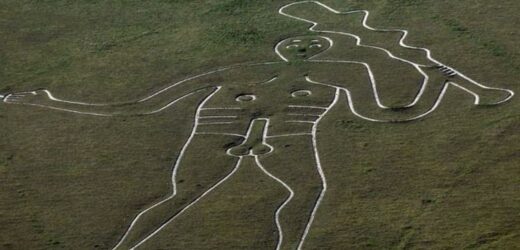Christianity ‘turned to archaeology to promote bible’ says expert
We use your sign-up to provide content in ways you’ve consented to and to improve our understanding of you. This may include adverts from us and 3rd parties based on our understanding. You can unsubscribe at any time. More info
The Cerne Abbas Giant, a 180ft-tall figure that is carved with chalk into a Dorset hilltop, has baffled archaeologists and historians for generations, with many stumped as to why it was crafted. It has become an iconic site in the English countryside, and often referred to as “Rude Man” – on account of its detail, particularly around the giant’s private area. But new research has now determined exactly when the geoglyph was first made, with historians able to pinpoint the likely time period it came from.
It argues that Rude Man was created in the late-Saxon period – something of a surprise for researchers as there are no similar chalk figures known to date from that time period.
Mike Allen, a geoarchaeologist who has been working with the National Trust to gain a better understanding of Rude Man, said: “This is not what was expected.
“Many archaeologists and historians thought he was prehistoric or post-medieval, but not medieval.
“Everyone was wrong, and that makes these results even more exciting.”


Martin Papworth, from the National Trust, noted last month he was “flabbergasted” by the findings, adding that he thought the site was from the 17th century.
Mr Papworth added to the Guardian: “He’s not prehistoric, he’s not Roman, he’s sort of Saxon, into the medieval period.”
The project took place across the last 12 months, and saw researchers use “hi-tech sediment analysis” to gain the new insight into Rude Man.
It had often been expected that Rude Man would be from a similar time to other well-known geoglyph – including the Long Man of Wilmington in East Sussex, which dates back to the 16 century, reports suggest.
JUST IN: Archaeology breakthrough as ‘dramatic’ proof of Bible earthquake found

Mr Allen continued: “Archaeologists have wanted to pigeonhole chalk hill figures into the same period.
“But carving these figures was not a particular phase — they’re all individual figures, with local significance, each telling us something about that place and time.”
Analysis of the Cerne Abbas Giant detailed that it was formed after trenches just under a metre deep into the hillside, before crushed chalk was added in on top.
Local folklore claims that having intercourse on top of the man’s privates would help a couple conceive a child.
DON’T MISS:
Archeologists discover new Egyptian queen’s name as new temple found [ANALYSIS]
BBC historian: Archeology is for everyone, not colonialists [INSIGHT]
The Dig: Peggy Piggott’s ‘bumbling’ portrayal slammed by experts [LATEST]


Intriguingly, there is no mention of the figure in a survey of the Abbey lands from the 1540s, and nothing in a similar survey from 1617 carried out by John Norden, an English cartographer.
Research suggests that the earliest reference in writing about the Rude Man was found in 1694 – when a warden from St Mary’s Church, in Cerne Abbas, noted a three shilling repair to what was called “ye Giant”.
Cerne Abbey, which is in the town of Cerne Abbas, was founded in around 987 BC, which has often led some experts to speculate that the giant was crafted to help convert locals from worshipping “the early Ango-Saxon God Heil”.
But Mr Papworth questioned this.
He concluded: “Why would a rich and famous abbey—just a few yards away—commission, or sanction, a naked man carved in chalk on a hillside?”
Source: Read Full Article


